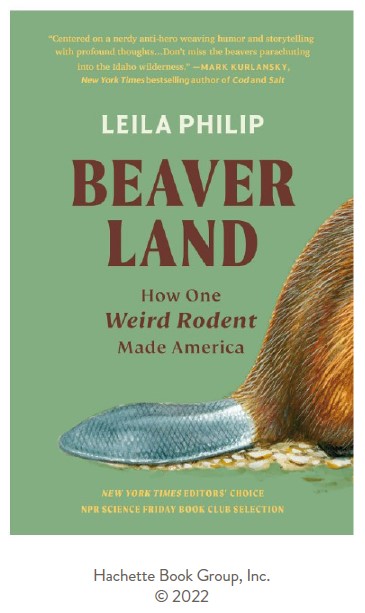
In the early pages of her most recent book, Beaverland, Leila Philip writes “The conversion of natural resources into power has always been the propelling force of empires.” Knowing a little about early American history, I assumed the book’s narrative would largely be an examination of the fur trade as a key driver to our nation’s early economic success. While this theme is indeed central to Philip’s book, the story she tells is far more interesting and complex.
To appreciate how beavers are intertwined with our nation’s history, you first need to understand a bit more about them than what you may remember from middle school science class. On this front Philip does not disappoint. We learn, for example, that beaver teeth grow continuously, and that one inch of their fur contains more hair than you have on your entire head. Thanks to some incredibly special physiology, they can stay under water for up to 15 minutes at a time and the fat stored in their tails provides a source of food during long winters of semi-hibernation. And on the economic front, Beaver pelts, not gold, served as a form of currency for our nation’s earliest communities. Philip too covers the beaver’s historic significance to the continent’s earliest indigenous populations and how fur trading permanently altered these communities.
The fur trade spanned roughly 300 years (1600-1900). By the 1860s, roughly half a million beavers were being “harvested” annually, largely for export to Europe where beaver fur was both fashionable and an important way to keep warm. A mere 40 years later, beavers were largely gone from the nation’s landscape. Great fortunes were built around this trade, including those of some of our nation’s earliest magnates like John Jacob Astor who had a near monopoly on the business in the late 1700s.
This somewhat grim history (for the beaver, anyway) is brought alive by the characters that Philip draws into her story. It turns out that beavers have been an object of fascination to many throughout history. Early beaver enthusiasts, like anthropologist Lewis Henry Morgan, viewed beavers in much the same way they did all natural resources – something to be managed largely for man’s benefit. Others, like Dorothy Richards and Enos Abijah Mills, who at various times both lived with beavers, took a different perspective. To these early wildlife conservationists, beavers were a “keystone” species, integral to preserving the nation’s wilderness, and more specifically, its water systems. Philip examines the ongoing tension between these two competing viewpoints which remains today. As one would expect, she includes the perspectives of a number of conservationists. But she takes a balanced approach in her research, also interviewing current day trappers and water management experts.
Admittedly, a treatise on beavers and their economic significance may not hold everyone’s attention. But Philip’s discussion of the role that beavers might play in the future is where the story gets interesting.
Perhaps to state the obvious, beavers should not be placed in the same category as our nation’s other critical economic resources, like oil. They are living, breathing creatures that have a unique capacity to both shape and adapt to their ever-changing environment. This adaptability helped them survive both the widespread trapping of the early Colonial period and the subsequent environmental destruction of their habitat. Encouragingly, this adaptability may also be what continues to ensure their survival. Philip devotes several chapters to examining how a broad coalition of researchers, environmentalists, and public policy advocates are now coming to understand the significant role that beavers can play in maintaining, and in many cases restoring, our nation’s wetlands. Wetlands filter out pollutants like nitrogen from agricultural run-off and foster important biodiversity. But these bodies of water also serve as a kind of sponge, soaking up excess water during periods of flooding and retaining it during periods of drought. Beavers could well be an important part of adapting to a future that likely includes more of both.